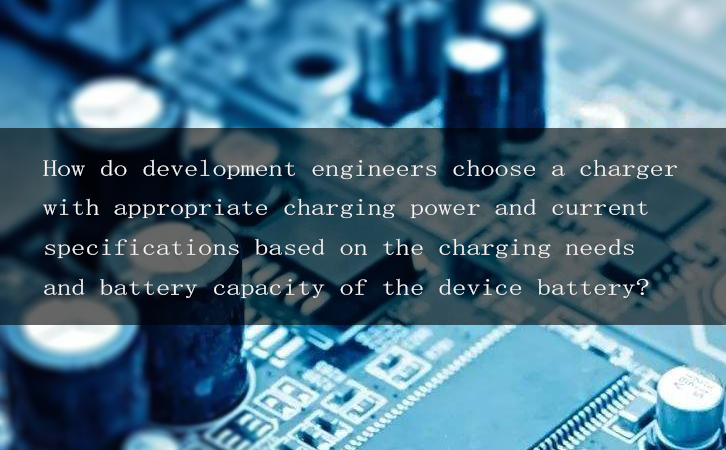Information Center
How do development engineers choose a charger with appropriate charging power and current specifications based on the charging needs and battery capacity of the device battery?
Published:2024-10-16 16:09:11 Author:admin Views:13Electronic product development engineers need to comprehensively consider the charging needs of the device's battery and its capacity when selecting the appropriate charging power and current specifications for a charger. Here are some detailed selection suggestions:

I. Clarify the Charging Needs of the Device's Battery
Understand Battery Characteristics:
Different types of batteries (such as lithium-ion batteries, nickel-metal hydride batteries, etc.) have different charging characteristics.
Lithium-ion batteries typically have high energy density and long cycle life but require controlled voltage and current during charging to prevent overcharging and over-discharging.
Determine Charging Speed Requirements:
Based on the device's usage scenario, determine the required charging speed.
For example, users of mobile devices like smartphones may desire fast charging to shorten waiting times.
Consider Charging Protocols:
Different devices may support different charging protocols (such as PD, QC, etc.).
Choosing a charger that supports the device's charging protocol ensures compatibility and efficiency during the charging process.
II. Assess the Relationship Between Battery Capacity and Charging Power
Calculate Charging Time:
Use the formula "Charging Time = Battery Capacity (mAh) × Charging Voltage (V) / Charging Power (W)" to estimate charging time.
Note that this formula is an idealized estimation, and actual charging time may be affected by various factors (such as the charger's conversion efficiency, the battery's internal resistance, etc.).
Select Appropriate Charging Power:
Generally, higher charging power results in faster charging speeds.
However, excessively high charging power may damage the battery, reducing its lifespan.
Therefore, find a balance between charging speed and battery lifespan.
Consider Current Specifications:
The current specification also needs to match the device's charging needs.
Excessively high current may cause the battery to overheat or damage it, while excessively low current may prolong charging time.
III. Choose the Appropriate Charger Type
Original or Certified Charger:
Prefer the original charger provided by the device manufacturer or a certified charger.
These chargers have typically undergone rigorous testing and certification, ensuring the safety and stability of the charging process.
Fast Charging Charger:
If the device supports fast charging, choose a charger that supports the corresponding fast charging protocol.
Fast charging chargers can provide a large amount of electrical energy to the device in a short period, but attention should be paid to the charger's cooling performance and battery temperature management.
Smart Charger:
Smart chargers can automatically adjust charging power and current based on the device's charging needs and battery capacity.
This type of charger usually has functions such as overcharge protection, over-discharge protection, short-circuit protection, and temperature control protection, ensuring the safety and stability of the charging process.
IV. Conduct Actual Testing and Verification
Test Charging Performance:
After selecting the charger, conduct actual testing to verify its charging performance and stability.
Professional charging test equipment or software can be used to monitor parameters such as voltage, current, and power during the charging process.
Observe Battery Status:
During charging, observe the battery's temperature, voltage, and capacity status.
If anomalies or instability occur, stop charging immediately and inspect the situation.
Record Test Results:
Record data and results from the testing process for subsequent analysis and improvement.
If test results do not meet expectations, reselect the charger or make further optimizations.
In summary, electronic product development engineers need to comprehensively consider the charging needs of the device's battery, its capacity, the charger type, and actual testing and verification when selecting the appropriate charging power and current specifications for a charger. By carefully comparing and evaluating different options, they can find the charger that best suits the device's battery.
SHENZHEN GREEN DIGITAL POWER TECH CO., LTD is a professional battery charger manufacturer that can give appropriate suggestions on charger selection and can design and customize exclusive chargers according to customer needs.
IntroductionGolf carts serve as vital transportation tools on golf courses, and their performance and reliability are crucial for enhancing player experience an···
The battery pack is the heart of a golf cart, silently powering every acceleration and climb on the green. However, battery degradation often goes unnoticed, mu···
The battery pack is the heart of a golf cart’s power system, yet maintaining it has long been a challenge for technicians. Traditional troubleshooting methods—···
For golf course managers, ensuring smooth and efficient operations is crucial for providing a memorable experience for golfers and maintaining the reputation of···





